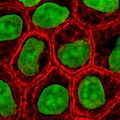Intermediate filament
Intermediate filaments are a type of cytoskeletal component found in the cells of vertebrates, and many invertebrates. They are involved in a variety of cellular processes, including cell shape, cell movement, and cell division.
Structure[edit]
Intermediate filaments are named for their intermediate size, with a diameter of about 10 nanometers, which is between the size of microtubules and microfilaments. They are composed of a variety of proteins, which are grouped into six types based on their structure and function. These include keratins, vimentins, neurofilaments, lamins, and others.
Function[edit]
The primary function of intermediate filaments is to provide mechanical support for the cell. They form a network that helps maintain the shape of the cell, and they also anchor the nucleus and other organelles in place. In addition, they are involved in cell movement and cell division.
Diseases[edit]
Mutations in the genes that encode intermediate filament proteins can lead to a variety of diseases. For example, mutations in keratin genes can cause skin diseases such as epidermolysis bullosa simplex, while mutations in lamin genes can cause progeria, a disease that causes premature aging.
See also[edit]
References[edit]
<references />
|
|
|
Intermediate_filament[edit]
-
Structure of an intermediate filament protein
-
Structure of another intermediate filament protein
-
Diagram of an intermediate filament
-
Epithelial cells showing intermediate filaments
-
Vimentin, a type of intermediate filament protein
Ad. Transform your life with W8MD's Budget GLP-1 injections from $75


W8MD offers a medical weight loss program to lose weight in Philadelphia. Our physician-supervised medical weight loss provides:
- Weight loss injections in NYC (generic and brand names):
- Zepbound / Mounjaro, Wegovy / Ozempic, Saxenda
- Most insurances accepted or discounted self-pay rates. We will obtain insurance prior authorizations if needed.
- Generic GLP1 weight loss injections from $75 for the starting dose.
- Also offer prescription weight loss medications including Phentermine, Qsymia, Diethylpropion, Contrave etc.
NYC weight loss doctor appointmentsNYC weight loss doctor appointments
Start your NYC weight loss journey today at our NYC medical weight loss and Philadelphia medical weight loss clinics.
- Call 718-946-5500 to lose weight in NYC or for medical weight loss in Philadelphia 215-676-2334.
- Tags:NYC medical weight loss, Philadelphia lose weight Zepbound NYC, Budget GLP1 weight loss injections, Wegovy Philadelphia, Wegovy NYC, Philadelphia medical weight loss, Brookly weight loss and Wegovy NYC
|
WikiMD's Wellness Encyclopedia |
| Let Food Be Thy Medicine Medicine Thy Food - Hippocrates |
Medical Disclaimer: WikiMD is not a substitute for professional medical advice. The information on WikiMD is provided as an information resource only, may be incorrect, outdated or misleading, and is not to be used or relied on for any diagnostic or treatment purposes. Please consult your health care provider before making any healthcare decisions or for guidance about a specific medical condition. WikiMD expressly disclaims responsibility, and shall have no liability, for any damages, loss, injury, or liability whatsoever suffered as a result of your reliance on the information contained in this site. By visiting this site you agree to the foregoing terms and conditions, which may from time to time be changed or supplemented by WikiMD. If you do not agree to the foregoing terms and conditions, you should not enter or use this site. See full disclaimer.
Credits:Most images are courtesy of Wikimedia commons, and templates, categories Wikipedia, licensed under CC BY SA or similar.
Translate this page: - East Asian
中文,
日本,
한국어,
South Asian
हिन्दी,
தமிழ்,
తెలుగు,
Urdu,
ಕನ್ನಡ,
Southeast Asian
Indonesian,
Vietnamese,
Thai,
မြန်မာဘာသာ,
বাংলা
European
español,
Deutsch,
français,
Greek,
português do Brasil,
polski,
română,
русский,
Nederlands,
norsk,
svenska,
suomi,
Italian
Middle Eastern & African
عربى,
Turkish,
Persian,
Hebrew,
Afrikaans,
isiZulu,
Kiswahili,
Other
Bulgarian,
Hungarian,
Czech,
Swedish,
മലയാളം,
मराठी,
ਪੰਜਾਬੀ,
ગુજરાતી,
Portuguese,
Ukrainian








